Lab 4: Concert Ticket App
You will be developing concert ticket app that lets you select predifined bands and check the cost of each ticket. The Concert Ticket App is demoed right:
|

|
Colours used:
0XFF1E2C41
0XFFE3E3E6
Setting Up the Project
Video @ 1:13 - 4:40
-
Create a New Project:
- Select "Empty Activity" and click "Next".
- Name your application "Concert Tickets".
- Ensure the package name is set to
com.uog.concerttickets. - Set the minimum API level to 24.
- Click "Finish" to create the project.
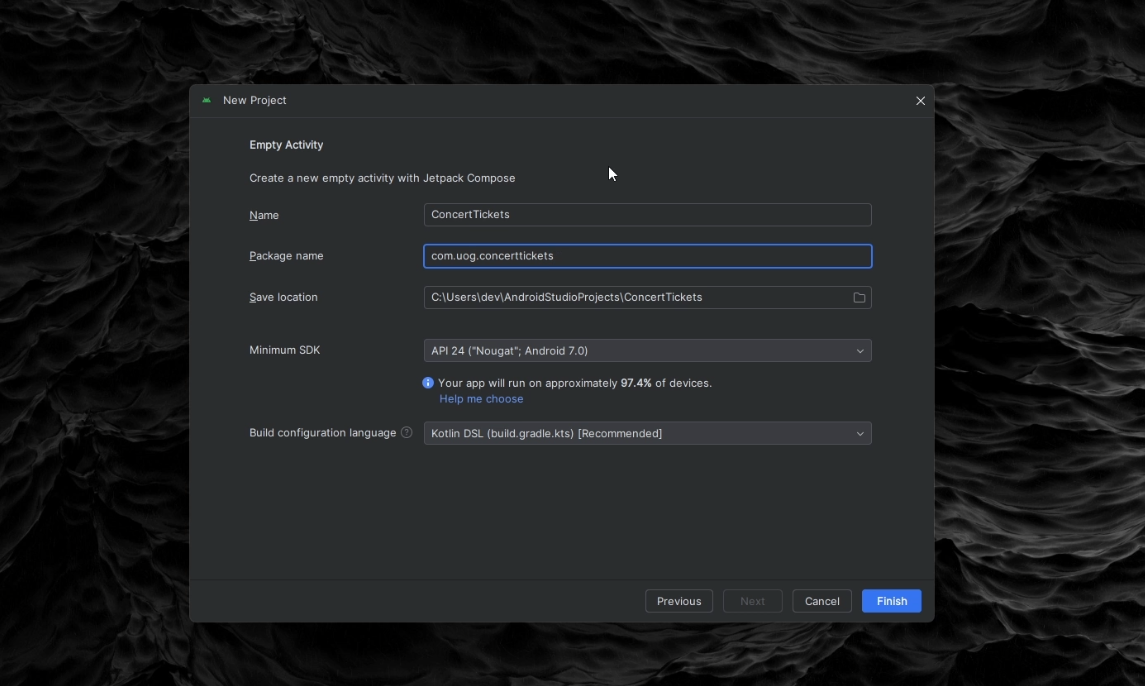
-
Adding images and creating logo assest
-
All the images are available in the Pictures folder downloaded in the zip. Drag the files to the mipmap folder.
-
For the assest right clock the
concert_ticket_logo.pngand get theabsolute path -
right click the res folder and add new image asset
-
In the Path: field paste the Absolute File path you copied earlier, and then select the file.
-
Click the Next button to add the custom launcher icon.
-
On the next dialog window, click the Finish button. The custom icons will be displayed in
res/mipmapfolder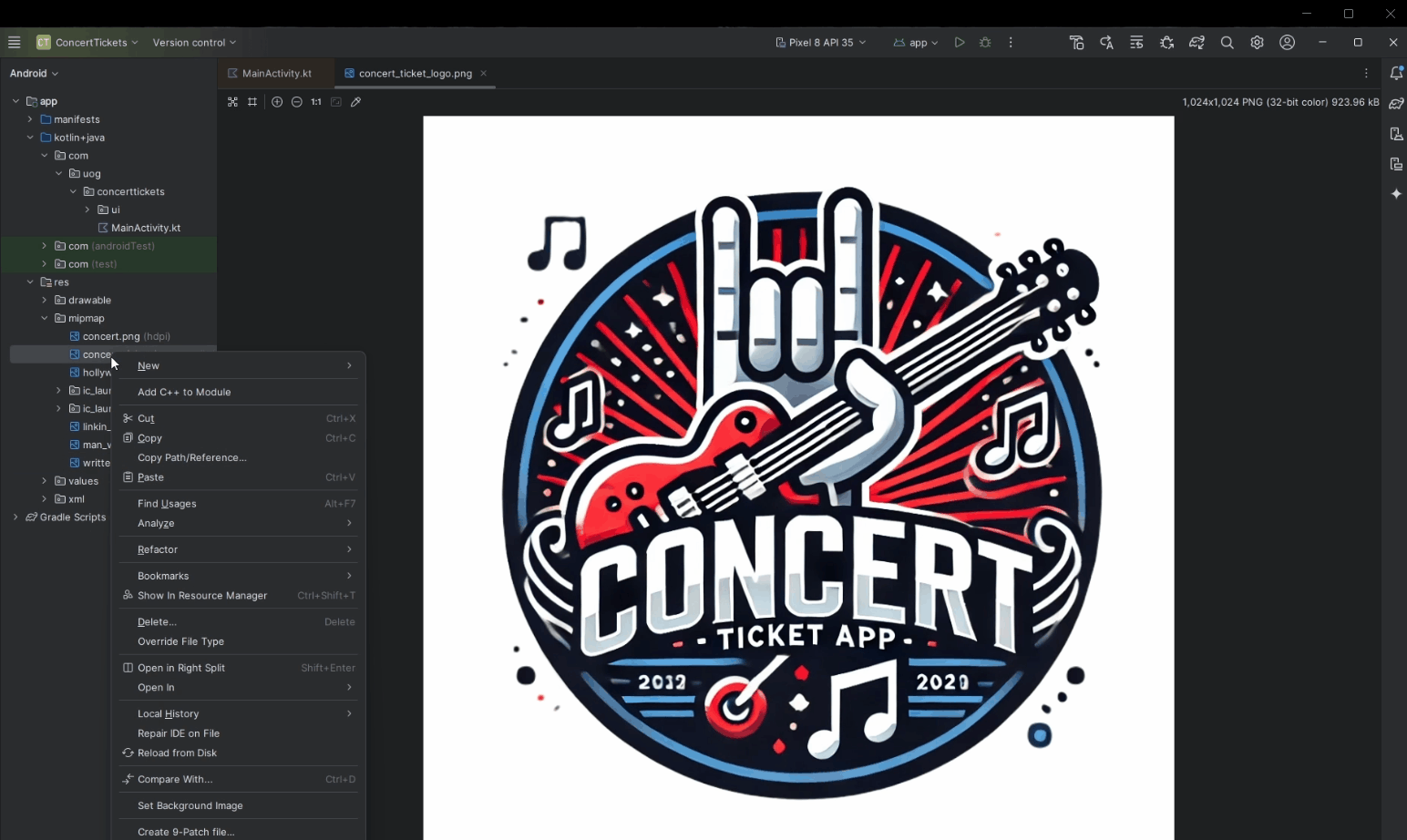
-
Modifying MainActivity
Video @ 4.40 - 17.35
-
Modify the Main Activity Layout:
-
Open
MainActivity.kt. -
Reprodce this:
package com.uog.concerttickets ... class MainActivity : ComponentActivity() { override fun onCreate(savedInstanceState: Bundle?) { super.onCreate(savedInstanceState) enableEdgeToEdge() setContent { ConcertTicketsTheme { ConcertTicketApp() } } } } @OptIn(ExperimentalMaterial3Api::class) @Composable fun ConcertTicketApp(){ Scaffold( topBar = { TopAppBar( modifier = Modifier .fillMaxWidth() .height(50.dp), title = { /* TODO */} ) } ) { innerPadding -> Surface(modifier = Modifier.padding(innerPadding)) { } } } @Preview(showBackground = true) @Composable fun GreetingPreview() { ConcertTicketsTheme { ConcertTicketApp() } }-
Scaffold: Provides a basic structure for the app’s layout, including slots for common UI components such as
TopAppBar,BottomAppBar, oatingActionButton, andDrawer`. -
TopAppBar: A composable that represents the top app bar, which usually contains the app title, navigation icons, and actions
-
Modifier: A flexible way to describe how a composable should be laid out, styled, or behave.
-
Surface: A composable that provides a background and other properties like elevation and shape, often used as a container for other composables
-
@OptIn: An annotation that indicates the usage of an experimental API
-
enableEdgeToEdge(): This function is typically used to set up the app to render edge-to-edge, utilizing the full screen area
-
-
You can modify the title element to hold an image and text:
title = { Row( verticalAlignment = Alignment.CenterVertically, modifier = Modifier.fillMaxWidth() ){ Image(painter = painterResource(id = R.mipmap.concert_ticket_logo), contentDescription = "App Logo", modifier = Modifier.size(50.dp)) Spacer(modifier = Modifier .align(alignment = Alignment.CenterVertically) .background(Color.White)) Text( text = stringResource(id = R.string.app_name), fontWeight = FontWeight.Bold, color = Color(0XFF1E2C41)) } }
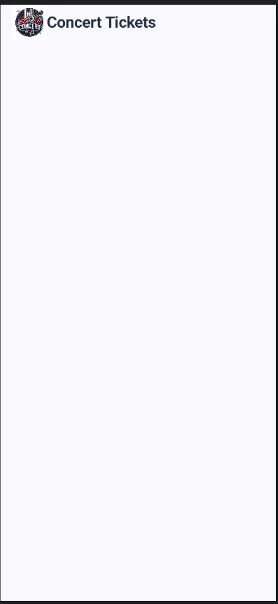
-
-
Modify the string resoucre app_name so that there is a space between the
ConcertTicketslike soConcert Tickets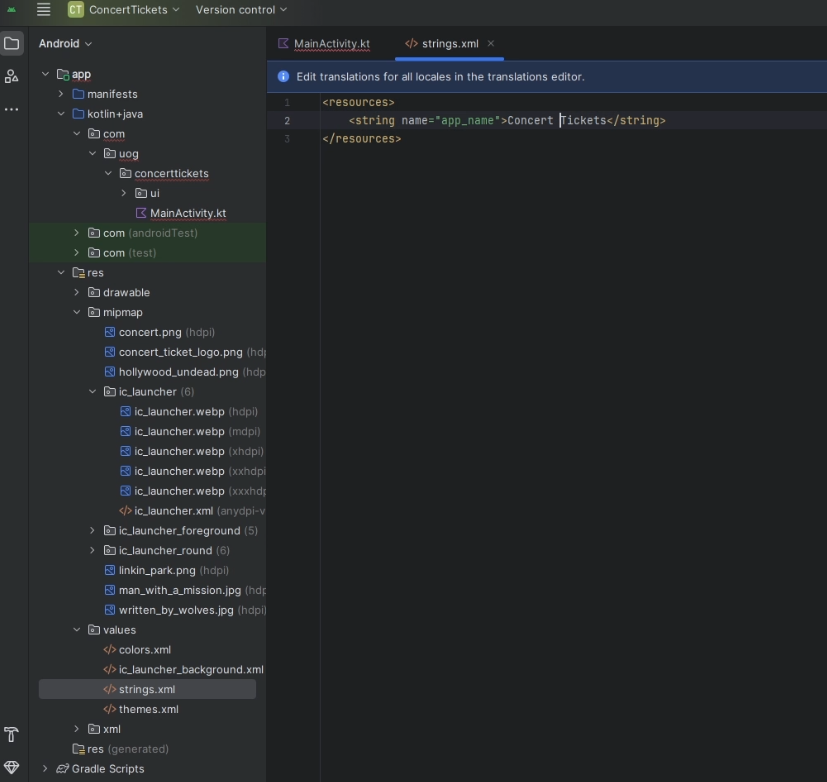
-
We need to create several composables that will show the DropDownMenu, TextField, Text, Button and Image, reproduce the following, inside the
SurfaceComposable add the followingColumn:... ) { innerPadding -> Surface(modifier = Modifier.padding(innerPadding)) { Column(modifier = Modifier.fillMaxSize()) { // Band Selection } } ...-
Row: Layout composable that arranges its children in a horizontal sequence.
-
Image: A composable for displaying images.
-
Spacer: A composable that creates an empty space in the layout
-
Text: A composable for displaying text.
-
Column: A layout composable that arranges its children in a vertical sequence
-
BandSelection, Band and Band Data
Video @ 17.35 - 44.10
-
Underneath the ConcertTicketApp Composable create a new Composable that will handle our Band Selection, called
BandSelection(selectedBand : Band)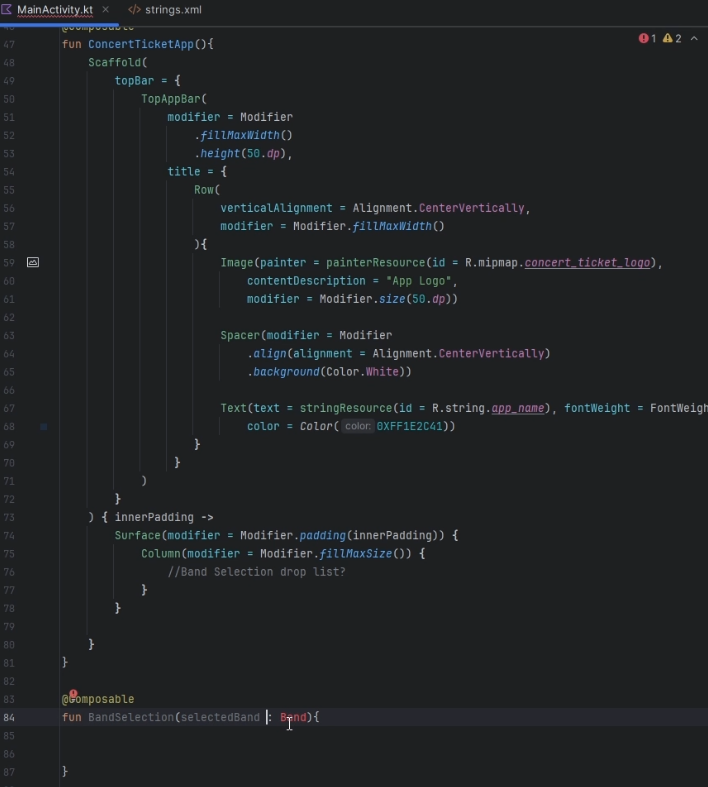
-
Now we need to create the
Banddata class, navigate to the top of the file and between theimport's and theMainActivitydefinition and create adata Class Band()with the following fields: -
Next we need to add the
object BandDataSourceunderneath thedata classwe just defined, that will hold the static band data:object BandDataSource { val bands = listOf( Band("Select a Band", R.mipmap.concert,0.0f), Band("Written By Wolves", R.mipmap.written_by_wolves,24.95f), Band("Linkin Park", R.mipmap.linkin_park,63.95f), Band("Man with a Mission", R.mipmap.man_with_a_mission,36.00f), Band("Hollywood Undead", R.mipmap.hollywood_undead,125.00f) ) }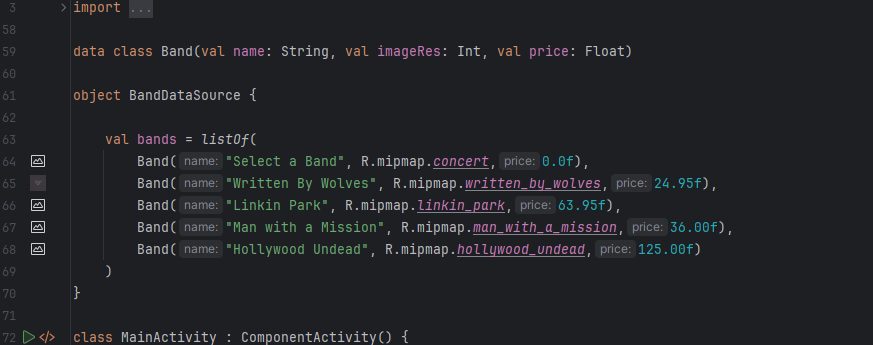
-
data class: A
data classin Kotlin is used to hold data. It automatically provides several useful methods, such asequals(),hashCode(),toString(), dcopy(), based on the properties defined in the class. -
object: In Kotlin, the
objectkeyword is used to declare a singleton, which means there will be only one instance ofBandDataSourcein the app.- Predefined Band List: A list containing instances of the
Banddata class. Each instance has a name, an image resource ID, and a price.
- Predefined Band List: A list containing instances of the
-
-
Go back to
BandSelectionComposable and we no modify the arguments and the body:@Composable fun BandSelection(selectedBand : Band, onBandSelected: (Band) -> Unit){ var expanded by remember { mutableStateOf(false)} Row( modifier = Modifier.fillMaxWidth(), horizontalArrangement = Arrangement.Center ){ Box(modifier = Modifier .background(Color(0XFFE3E3E1), RoundedCornerShape(8.dp)) .padding(8.dp) .fillMaxWidth() ){ TextButton( onClick = { expanded = true }, modifier = Modifier.fillMaxWidth()) { Row(modifier = Modifier.fillMaxWidth()) { } } } } }-
remember:
rememberis a composable function that allows a state to be remembered across recompositions -
mutableStateOf:
mutableStateOfis used to create a state variable that can be observed for changes. -
Putting both together, they are used to hold and manage state in Jetpack Compose.
-
Box: A layout composable that places its children on top of each other (like a stack) with the first child on the bottom
-
TextButton: A button composable that displays text. It is used for simple text-based buttons without background or elevation
-
onBandSelection: A lambda function that takes a
Bandas a parameter and returnsUnit. This function is called when a new band is selected, allowing the rent composable to update the selected band. -
Unit: is a type that corresponds to
voidin other programming languages. It is used to indicate that a function does not return any meaningful value. When a function returnsUnit, it means that the function's purpose is to perform some action rather than produce a result.
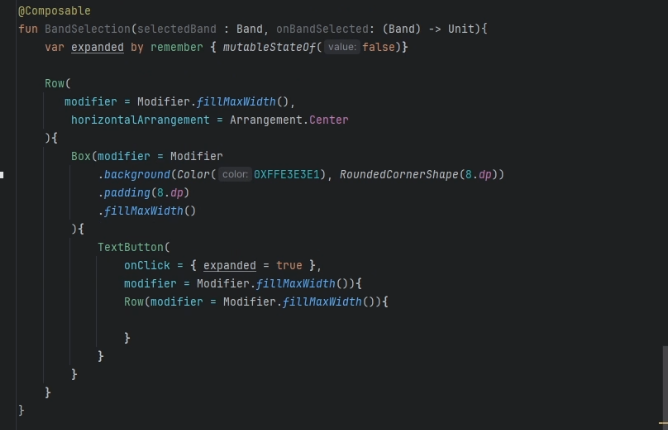
-
-
Go back to the top of the
ConcertTicketAppand add a new remember initialisation so that when a band is selected and the recompostion is invoked the band selected is stored presistently across recompositions.@OptIn(ExperimentalMaterial3Api::class) @Composable fun ConcertTicketApp(){ var selectedBand by remember { mutableStateOf(BandDataSource.bands[0]) } ... } -
Update the Surface too, so that we can preview the
BandSelection... Surface(modifier = Modifier.padding(innerPadding)) { Column(modifier = Modifier.fillMaxSize()) { BandSelection(selectedBand = selectedBand) {selectedBand = it } ...Lambda Function
{selectedBand = it}: The lambda function takes a band (it) as a parameter and assigns it to theselectedBandvariable. This updates the state with the newly selected band.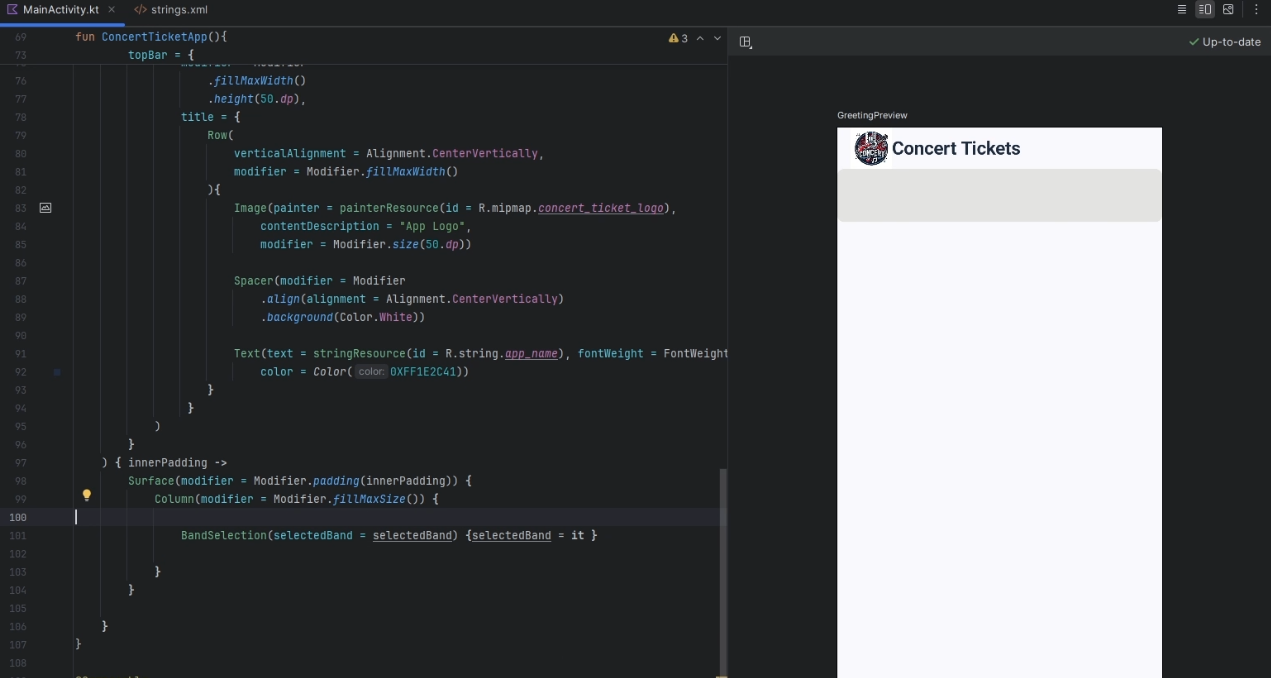
-
Continue modifying the
BandSelectioncomposableRowso:... Row(modifier = Modifier.fillMaxWidth()) { Text( text = selectedBand.name, color = Color(0XFF1E2C41), fontSize = 25.sp) Icon(imageVector = ImageVector .vectorResource(id = R.drawable.ic_baseline_arrow_drop_down), contentDescription = "Dropdown Arrow", tint = Color.Black) } ...-
You need to create the
ic_baseline_arrow_drop_downassest, copy the code in the collaspable field below and create a new image resource :Code: ic_baseline_arrow_drop_down xml code
<vector xmlns:android="http://schemas.android.com/apk/res/android" android:height="24dp" android:viewportHeight="24" android:viewportWidth="24" android:width="24dp"> <path android:fillColor="#000000" android:fillType="evenOdd" android:pathData="M12.707,14.707C12.317,15.098 11.683,15.098 11.293,14.707L6.293,9.707C5.902,9.317 5.902,8.683 6.293,8.293C6.683,7.902 7.317,7.902 7.707,8.293L12,12.586L16.293,8.293C16.683,7.902 17.317,7.902 17.707,8.293C18.098,8.683 18.098,9.317 17.707,9.707L12.707,14.707Z"/> </vector>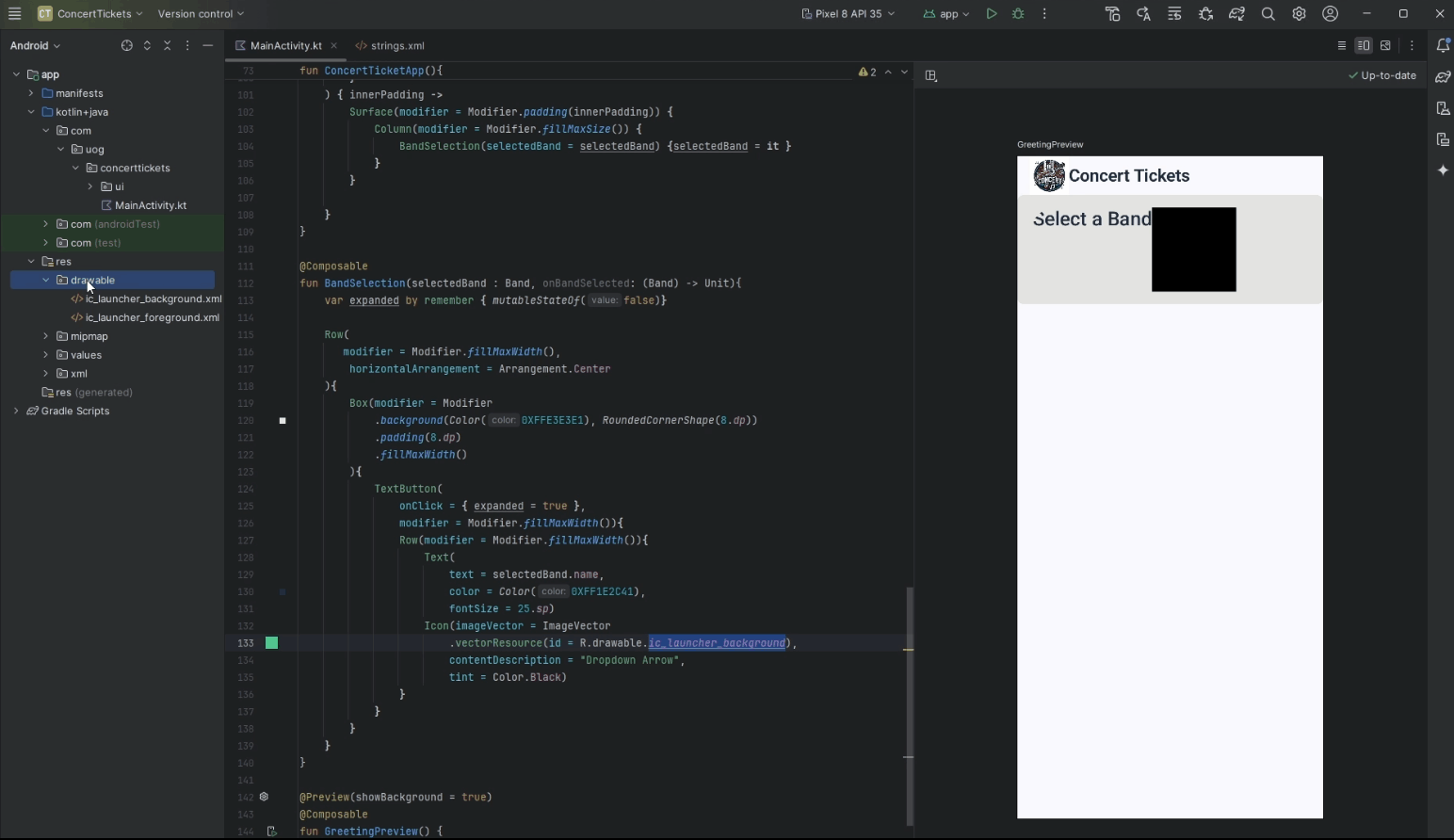
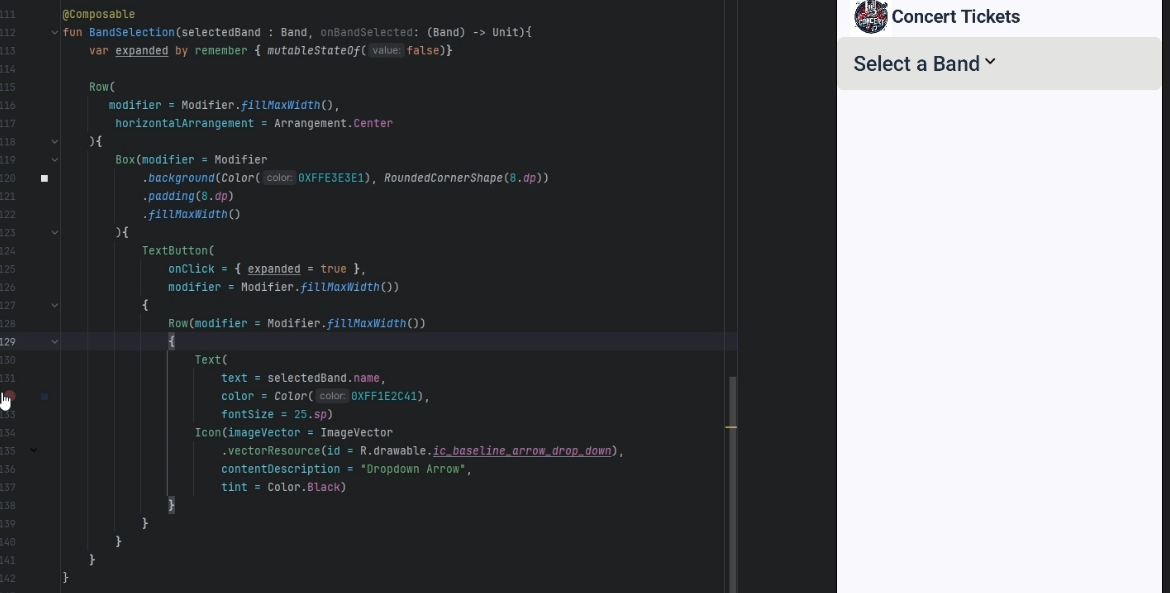
-
-
Following on we need to add the
DropDownMenuItem's so that theDropDownMenucan display eachBandname from the dropdown list:... DropdownMenu( expanded = expanded, onDismissRequest = { expanded = false }, modifier = Modifier .background(Color(0XFFE3E3E6)) .width(400.dp)) { BandDataSource.bands.forEach { band -> DropdownMenuItem(text = { Text( text = band.name, color = Color(0XFF1E2C41), fontSize = 25.sp) }, onClick = { onBandSelected(band) expanded = false}) } } ...-
This block dynamically creates a list of dropdown menu items for each band.#
- Each item's text is the band's name, styled with a specific color and font size.
- Clicking an item triggers a selection function and closes the dropdown menu.
-
BandDataSource.bands.forEach { band ->: this line iterates through a list of bands provided by
BandDataSource.bands, for each band in the list, the code ide theforEachblock is executed.- DropdownMenuItem: Menus display a list of choices on a temporary surface. They appear when users interact with a button, action, or other control.

-
BandSelection, Band Image
Video @ 44.10 - 46.35
-
Go back up to the
Surfacewhere we invoke ourBandSelection(...){...}, and reproduce the new lines below, several comments and a new function callBandImage(selectedBand)below:... innerPadding -> Surface(modifier = Modifier.padding(innerPadding)) { Column(modifier = Modifier.fillMaxSize()) { BandSelection(selectedBand = selectedBand) {selectedBand = it } //Text FOR TICKET COST //Calcuate the cost // Display the cost // display Band image BandImage(selectedBand) } } ... -
Navigate to the end of the file and create a new composable function called
BandImage(), like below:@Composable fun BandImage(selectedBand: Band) { Image( painter = painterResource(id = selectedBand.imageRes), contentDescription = null, contentScale = ContentScale.Fit, alignment = Alignment.Center, modifier = Modifier .fillMaxWidth() .height(300.dp)) }
BandSelection, TicketCost
Video @ 46.35 - 51.25
-
Go back up to the
Surfacewhere we invoke ourBandSelection(...){...}, and reproduce the new lines below, several comments and a new function callTicketInput(ticketCost)below:innerPadding -> Surface(modifier = Modifier.padding(innerPadding)) { Column(modifier = Modifier.fillMaxSize()) { BandSelection(selectedBand = selectedBand) {selectedBand = it } //Text FOR TICKET COST TicketInput(ticketCount){ticketCount = it} //Calcuate the cost // Display the cost // display Band image BandImage(selectedBand) } } -
Go back to the top of the
ConcertTicketAppand add a new remember initialisation so that when you use the input field and it recomposes each time the userinput is presistent,calledticketCount.@OptIn(ExperimentalMaterial3Api::class) @Composable fun ConcertTicketApp(){ var selectedBand by remember { mutableStateOf(BandDataSource.bands[0]) } var ticketCount by remember { mutableStateOf("") } ... } -
Navigate to the
BandImage(...)function and above the declaration add the new functionTextInput():@Composable fun TicketInput(ticketCount: String, onTicketCountChange: (String) -> Unit){ TextField(value = ticketCount, onValueChange = onTicketCountChange, label = { Text(text = "Number of Tickets")}, keyboardOptions = KeyboardOptions(keyboardType = KeyboardType.Number), modifier = Modifier.fillMaxWidth() ) }
BandSelection, CalculateCostButton
Video @ 51.25 - 1:03:17
-
Navigate back to
Surfaceand update the code to create some spacing betweenComposable's, a new function callCalcualteCostButtonand create a newremembertype calledtotalCost:innerPadding -> Surface(modifier = Modifier.padding(innerPadding)) { Column(modifier = Modifier.fillMaxSize()) { BandSelection(selectedBand = selectedBand) {selectedBand = it } Spacer(modifier = Modifier.height(32.dp)) //Text FOR TICKET COST TicketInput(ticketCount){ticketCount = it} Spacer(modifier = Modifier.height(42.dp)) //Calcuate the cost CalculateCostButton(selectedBand,ticketCount){totalCost = it} Spacer(modifier = Modifier.height(42.dp)) // Display the cost // display Band image BandImage(selectedBand) } }-
totalCostremembertype:@OptIn(ExperimentalMaterial3Api::class) @Composable fun ConcertTicketApp(){ var selectedBand by remember { mutableStateOf(BandDataSource.bands[0]) } var ticketCount by remember { mutableStateOf("") } var totalCost by remember { mutableStateOf("") } ...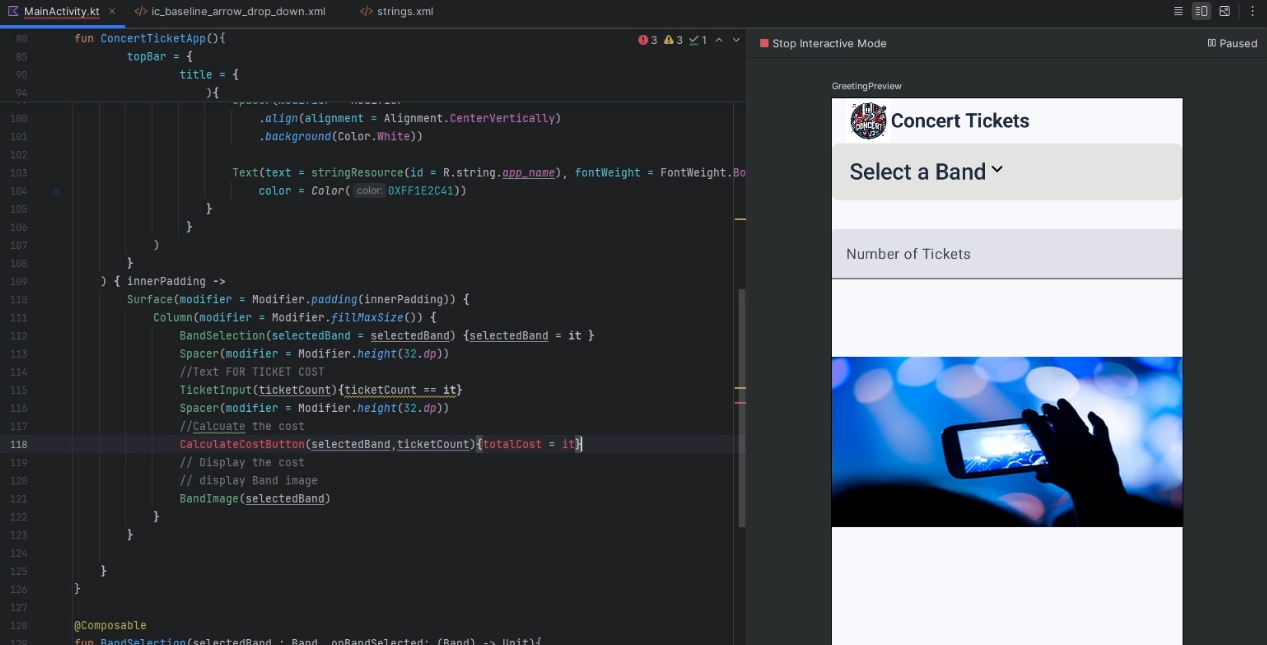
-
-
Navigate to the
TextInput()Composable, and declare the newly referenced functionCalculateCostButton:@Composable fun CalculateCostButton(selectedBand: Band,ticketCount: String,onCalculate: (String) -> Unit){ val costPerTicket = selectedBand.price val format: NumberFormat = NumberFormat.getCurrencyInstance().apply { currency = Currency.getInstance("GBP") maximumFractionDigits = 2 minimumFractionDigits = 2 } } -
Next in side the body of the function use the
ButtonComposable:Button(onClick = { val count = ticketCount.toIntOrNull() ?: 0 if (selectedBand.name == "Select a Band"){ onCalculate("Please Select a Band") } else if (count <= 0){ onCalculate("Enter value greater than 0") } else{ val total = costPerTicket * count onCalculate("Cost for ${selectedBand.name} is ${format.format(total)}") } }, modifier = Modifier .fillMaxWidth() .height(65.dp), colors = ButtonDefaults.buttonColors(contentColor = Color(0XFF1E2C41)) ) { Text(text = "Find Cost", fontSize = 20.sp, color = Color.White) }-
val count = ticketCount.toIntOrNull() ?: 0:
ticketCount.toIntOrNull()attempts to convert theticketCountstring to an integer.- If the conversion fails (i.e.,
ticketCountis not a valid integer),toIntOrNull()returnsnull, and the Elvis operator (?:) assigns0tocount. - This ensures that count is always an integer, defaulting to
0if the conversion fails
- If the conversion fails (i.e.,
-
onCalculate("Cost for ${selectedBand.name} is ${format.format(total)}"):
- "
Cost for ${selectedBand.name} is ${format.format(total)}": This is a string with interpolated expressions inside it. In Kotlin, string interpolation allows u to include variables or expressions within a string by enclosing them in${}
- "
-
${selectedBand.name}: This expression accesses the name property of the
selectedBandobject and inserts its value into the string. -
${format.format(total)}: This expression formats the total value as a currency string using the format object, which is an instance of
NumberFormatconfigured for currency formatting.
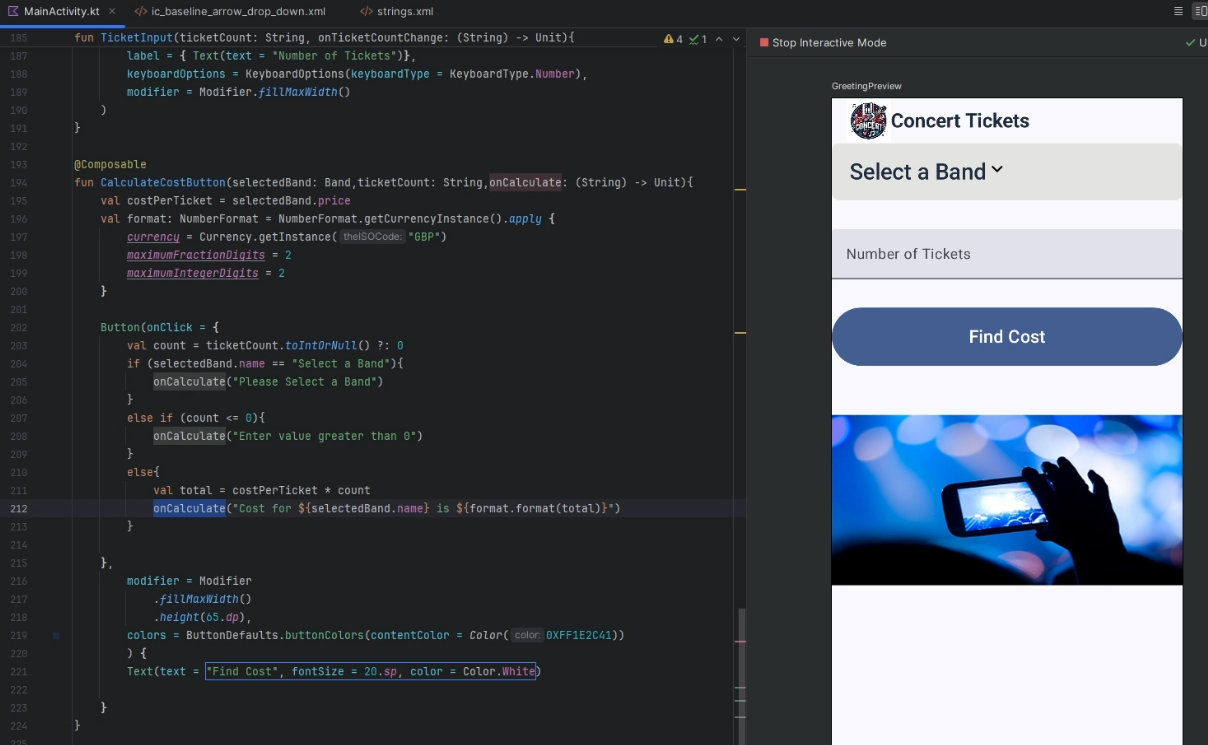
-
BandSelection, CostDisplay
Video @ 1:03:17 - 1:05:38
-
Navigate back to
Surfaceand update the code to create some spacing betweenComposable's, a new function callCostDisplay:innerPadding -> Surface(modifier = Modifier.padding(innerPadding)) { Column(modifier = Modifier.fillMaxSize()) { BandSelection(selectedBand = selectedBand) {selectedBand = it } Spacer(modifier = Modifier.height(32.dp)) //Text FOR TICKET COST TicketInput(ticketCount){ticketCount = it} Spacer(modifier = Modifier.height(42.dp)) //Calcuate the cost CalculateCostButton(selectedBand,ticketCount){totalCost = it} Spacer(modifier = Modifier.height(42.dp)) // Display the cost CostDisplay(totalCost) Spacer(modifier = Modifier.height(42.dp)) // display Band image BandImage(selectedBand) } } -
Navigate to the
BandImage()Composable, and declare the newly referenced functionCostDisplay:@Composable fun CostDisplay(totalCost : String){ Text( text = totalCost, fontSize = 20.sp, color = Color.Black, modifier = Modifier.fillMaxWidth(), textAlign = TextAlign.Center) }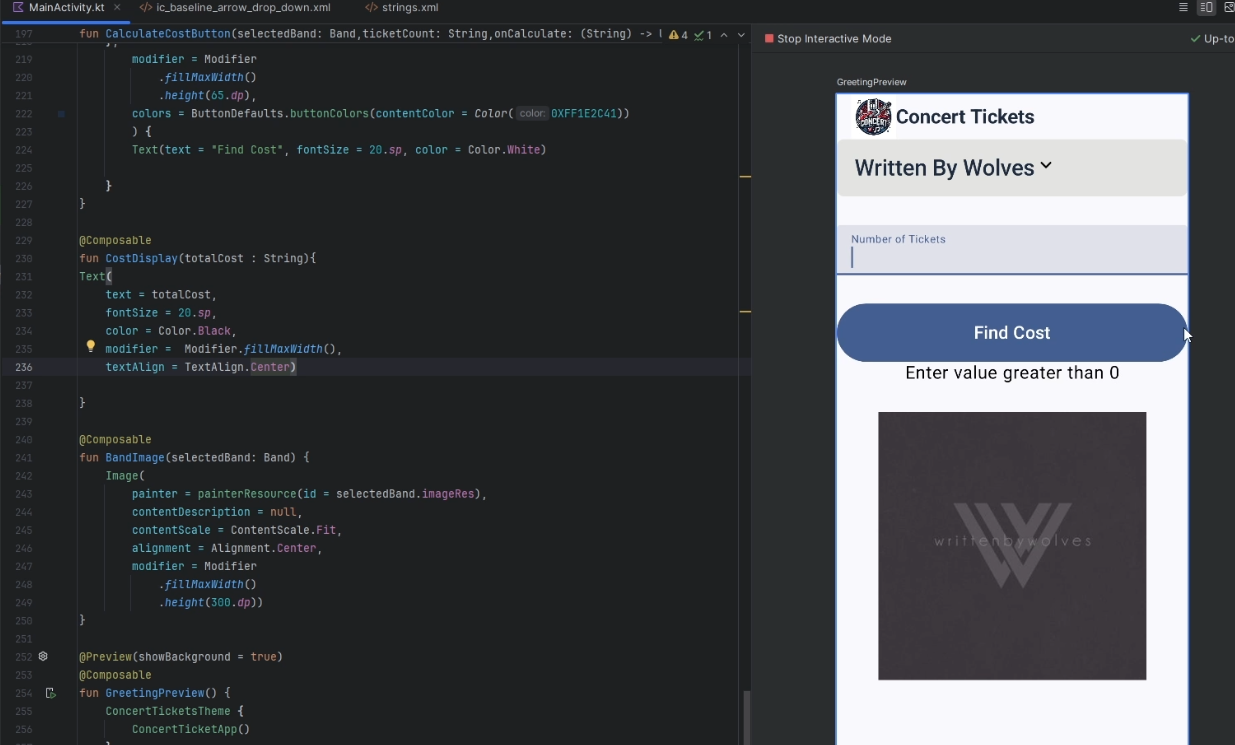
|
If you run the app you should now be able to reproduce the following: |

|
Code: whole program [255 lines]...
Code: whole program [255 lines]...
package com.uog.concerttickets
import android.icu.text.NumberFormat
import android.icu.util.Currency
import android.os.Bundle
import androidx.activity.ComponentActivity
import androidx.activity.compose.setContent
import androidx.activity.enableEdgeToEdge
import androidx.collection.mutableObjectIntMapOf
import androidx.compose.foundation.Image
import androidx.compose.foundation.background
import androidx.compose.foundation.layout.Arrangement
import androidx.compose.foundation.layout.Box
import androidx.compose.foundation.layout.Column
import androidx.compose.foundation.layout.Row
import androidx.compose.foundation.layout.Spacer
import androidx.compose.foundation.layout.fillMaxSize
import androidx.compose.foundation.layout.fillMaxWidth
import androidx.compose.foundation.layout.height
import androidx.compose.foundation.layout.padding
import androidx.compose.foundation.layout.size
import androidx.compose.foundation.layout.width
import androidx.compose.foundation.shape.RoundedCornerShape
import androidx.compose.foundation.text.KeyboardOptions
import androidx.compose.material3.Button
import androidx.compose.material3.ButtonDefaults
import androidx.compose.material3.DropdownMenu
import androidx.compose.material3.DropdownMenuItem
import androidx.compose.material3.ExperimentalMaterial3Api
import androidx.compose.material3.Icon
import androidx.compose.material3.Scaffold
import androidx.compose.material3.Surface
import androidx.compose.material3.Text
import androidx.compose.material3.TextButton
import androidx.compose.material3.TextField
import androidx.compose.material3.TopAppBar
import androidx.compose.runtime.Composable
import androidx.compose.runtime.currentComposer
import androidx.compose.runtime.getValue
import androidx.compose.runtime.mutableStateOf
import androidx.compose.runtime.remember
import androidx.compose.runtime.setValue
import androidx.compose.ui.Alignment
import androidx.compose.ui.Modifier
import androidx.compose.ui.graphics.Color
import androidx.compose.ui.graphics.vector.ImageVector
import androidx.compose.ui.layout.ContentScale
import androidx.compose.ui.res.painterResource
import androidx.compose.ui.res.stringResource
import androidx.compose.ui.res.vectorResource
import androidx.compose.ui.text.font.FontWeight
import androidx.compose.ui.text.input.KeyboardType
import androidx.compose.ui.text.style.TextAlign
import androidx.compose.ui.tooling.preview.Preview
import androidx.compose.ui.unit.dp
import androidx.compose.ui.unit.sp
import com.uog.concerttickets.ui.theme.ConcertTicketsTheme
data class Band(val name: String, val imageRes: Int, val price: Float)
object BandDataSource {
val bands = listOf(
Band("Select a Band", R.mipmap.concert,0.0f),
Band("Written By Wolves", R.mipmap.written_by_wolves,24.95f),
Band("Linkin Park", R.mipmap.linkin_park,63.95f),
Band("Man with a Mission", R.mipmap.man_with_a_mission,36.00f),
Band("Hollywood Undead", R.mipmap.hollywood_undead,125.00f)
)
}
class MainActivity : ComponentActivity() {
override fun onCreate(savedInstanceState: Bundle?) {
super.onCreate(savedInstanceState)
enableEdgeToEdge()
setContent {
ConcertTicketsTheme {
ConcertTicketApp()
}
}
}
}
@OptIn(ExperimentalMaterial3Api::class)
@Composable
fun ConcertTicketApp(){
var selectedBand by remember { mutableStateOf(BandDataSource.bands[0]) }
var ticketCount by remember { mutableStateOf("") }
var totalCost by remember { mutableStateOf("") }
Scaffold(
topBar = {
TopAppBar(
modifier = Modifier
.fillMaxWidth()
.height(50.dp),
title = {
Row(
verticalAlignment = Alignment.CenterVertically,
modifier = Modifier.fillMaxWidth()
){
Image(painter = painterResource(id = R.mipmap.concert_ticket_logo),
contentDescription = "App Logo",
modifier = Modifier.size(50.dp))
Spacer(modifier = Modifier
.align(alignment = Alignment.CenterVertically)
.background(Color.White))
Text(text = stringResource(id = R.string.app_name), fontWeight = FontWeight.Bold,
color = Color(0XFF1E2C41))
}
}
)
}
) { innerPadding ->
Surface(modifier = Modifier.padding(innerPadding)) {
Column(modifier = Modifier.fillMaxSize()) {
BandSelection(selectedBand = selectedBand) {selectedBand = it }
Spacer(modifier = Modifier.height(32.dp))
//Text FOR TICKET COST
TicketInput(ticketCount){ticketCount = it}
Spacer(modifier = Modifier.height(42.dp))
//Calcuate the cost
CalculateCostButton(selectedBand,ticketCount){totalCost = it}
Spacer(modifier = Modifier.height(42.dp))
// Display the cost
CostDisplay(totalCost)
Spacer(modifier = Modifier.height(42.dp))
// display Band image
BandImage(selectedBand)
}
}
}
}
@Composable
fun BandSelection(selectedBand : Band, onBandSelected: (Band) -> Unit){
var expanded by remember { mutableStateOf(false)}
Row(
modifier = Modifier.fillMaxWidth(),
horizontalArrangement = Arrangement.Center
){
Box(modifier = Modifier
.background(Color(0XFFE3E3E1), RoundedCornerShape(8.dp))
.padding(8.dp)
.fillMaxWidth()
){
TextButton(
onClick = { expanded = true },
modifier = Modifier.fillMaxWidth())
{
Row(modifier = Modifier.fillMaxWidth())
{
Text(
text = selectedBand.name,
color = Color(0XFF1E2C41),
fontSize = 25.sp)
Icon(imageVector = ImageVector
.vectorResource(id = R.drawable.ic_baseline_arrow_drop_down),
contentDescription = "Dropdown Arrow",
tint = Color.Black)
}
}
DropdownMenu(
expanded = expanded,
onDismissRequest = { expanded = false },
modifier = Modifier
.background(Color(0XFFE3E3E6))
.width(400.dp)) {
BandDataSource.bands.forEach { band ->
DropdownMenuItem(text = {
Text(
text = band.name,
color = Color(0XFF1E2C41),
fontSize = 25.sp)
}, onClick = {
onBandSelected(band)
expanded = false})
}
}
}
}
}
@Composable
fun TicketInput(ticketCount: String, onTicketCountChange: (String) -> Unit){
TextField(value = ticketCount, onValueChange = onTicketCountChange,
label = { Text(text = "Number of Tickets")},
keyboardOptions = KeyboardOptions(keyboardType = KeyboardType.Number),
modifier = Modifier.fillMaxWidth()
)
}
@Composable
fun CalculateCostButton(selectedBand: Band,ticketCount: String,onCalculate: (String) -> Unit){
val costPerTicket = selectedBand.price
val format: NumberFormat = NumberFormat.getCurrencyInstance().apply {
currency = Currency.getInstance("GBP")
maximumFractionDigits = 2
minimumFractionDigits = 2
}
Button(onClick = {
val count = ticketCount.toIntOrNull() ?: 0
if (selectedBand.name == "Select a Band"){
onCalculate("Please Select a Band")
}
else if (count <= 0){
onCalculate("Enter value greater than 0")
}
else{
val total = costPerTicket * count
onCalculate("Cost for ${selectedBand.name} is ${format.format(total)}")
}
},
modifier = Modifier
.fillMaxWidth()
.height(65.dp),
colors = ButtonDefaults.buttonColors(contentColor = Color(0XFF1E2C41))
) {
Text(text = "Find Cost", fontSize = 20.sp, color = Color.White)
}
}
@Composable
fun CostDisplay(totalCost : String){
Text(
text = totalCost,
fontSize = 20.sp,
color = Color.Black,
modifier = Modifier.fillMaxWidth(),
textAlign = TextAlign.Center)
}
@Composable
fun BandImage(selectedBand: Band) {
Image(
painter = painterResource(id = selectedBand.imageRes),
contentDescription = null,
contentScale = ContentScale.Fit,
alignment = Alignment.Center,
modifier = Modifier
.fillMaxWidth()
.height(300.dp))
}
@Preview(showBackground = true)
@Composable
fun GreetingPreview() {
ConcertTicketsTheme {
ConcertTicketApp()
}
}
Continue Here...
You will need to download the following picture folder -> Lab_4-2_Picture.zip
For the exercises below, follow the steps in the Ticket Vault example (above).
1. Catalina Island Boat Express App
| Application Title | Catalina Island Boat Express App |
|---|---|
| Purpose | Catalina Express has 30 daily departures between Long Beach and Catalina Island. Create a simple app that determines how many boat tickets the user needs and whether the ticket is for going to Catalina Island or heading back to Long Beach. The app displays the total price for the fare in one direction |
| Algorithm 1: | The app displays a title; an image (provided in the Pictures folder at top of workbook), and a Text Field, Spinner, and Button control. The two options in the Spinner control include To Catalina Island and To Long Beach. Each single passenger ticket is $34 for one way. |
| Algorithm 2: | When the user taps or clicks the Button control, the number of tickets and the total cost of the fare is displayed |
| Alogrithm 3: | Use a black theme, Spinner prompt, string array, and a hint property. |
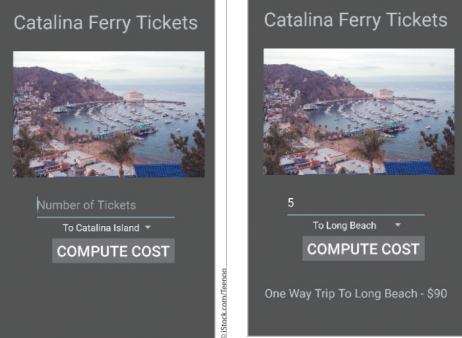
2. Triathlon Registration App
| Application Title | Triathlon Registration App |
|---|---|
| Purpose | A triathlon registration app allows an athlete to register for one of three national triathlons to qualify for the Ironman World Championship |
| Algorithm 1: | The triathlon registration app has two Text Fields: one requests the number of athletes on the user’s team and the other requests the location. A Spinner control allows the athlete to select one of three possible locations: Lake Placid, Big Island Hawaii, and Miami. The app also displays a title, an image (called triathlon.png in the Pictures folder you downloaded) and a Button control. |
| Algorithm 2: | After the user clicks the Button control, the selected location and the total team coast are displayed in the TextView control. |
| Algorithm 3: | Use a theme, a title, an image, a Spinner prompt, a string array, and a hint property |
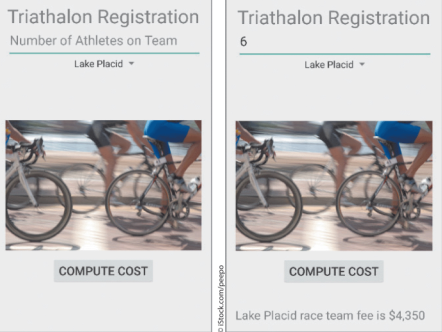
3. Medway Cab Fare App
| Application Title | Medway Cab Fare App |
|---|---|
| Purpose | Create an app that estimates the cost for cab fare in Medway. The app calculates the cost of the trip and request a reservation for a smart car, traditional sedan or a minivan |
| Algorithm 1: | The app requests the distance in miles for the cab ride and your preference for the requested cab: a smart car, traditional sedan or a minivan. The cab fare has an initial fee of £3.00. The mileage rate of £3.50 is also charged. |
| Algorithm 2: | The app displays the name of a cab company (do your own research what kind of cab companies are available in Medway and choose one), a picture of a logo, and the results of the requested type of cab with the cost of the fare. Create your own layout. |
| Algorithm 3: | Use a theme, Spinner prompt, string array, and hint property. Decimal mileage is possible. |
4. Split the Bill App
| Application Title | Split the Bill App |
|---|---|
| Purpose | You are out with friends at a nice restaurant. This app splits the bill, including the tip, among the members of your party. |
| Algorithm 1: | A welcome screen displays the title, image, and button that displays a second screen when clicked. The input/output screen requests the restaurant bill and the number of people in your group. The Spinner control asks about the quality of service: Excellent, Average or Poor. |
| Algorithm 2: | Calculate a 15% tip and divide the restaurant bill with the tip included among the members of your party. Display the tip amount and the individual share of the bill. |
| Algorithm 3: | Use a theme, Spinner prompt, string array, and hint property. |